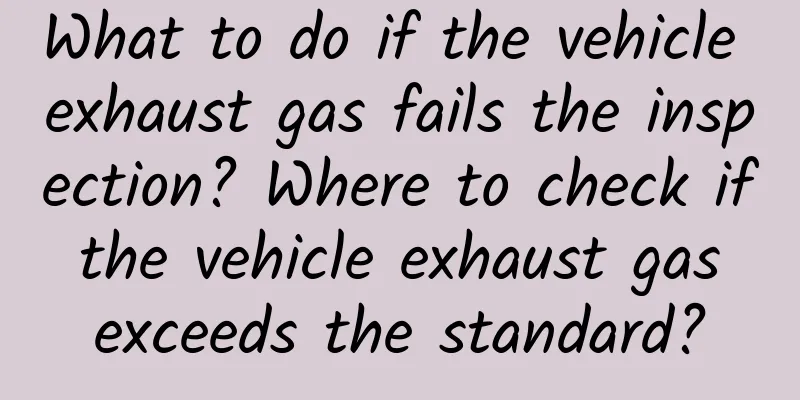What to do if the vehicle exhaust gas fails the inspection? Where to check if the vehicle exhaust gas exceeds the standard?

|
Exhaust is an indicator of automobiles that is checked every year. Automobile exhaust contains hundreds of different compounds, which are harmful to human health and have an impact on the ecological environment. Therefore, the detection of exhaust is an important item in the annual inspection. What should I do if the exhaust fails the inspection? What to do if the vehicle exhaust gas inspection failsFirst, try to find an agent or a scalper to handle the problem. If your vehicle's exhaust gas is not up to standard, it may not be the real problem. If you can't find a scalper to solve the problem, you have to find the problem with the vehicle itself. The exhaust gas generally tests carbon monoxide, hydrocarbons and nitrogen oxides. For vehicles with many years of use, carbon monoxide is usually unqualified. For vehicles that have been using gas for more than two years after the change, hydrocarbons and nitrogen oxides are usually unqualified. There are many reasons for the failure of exhaust gas. For example, the aging of the three-way catalytic converter, the burning of engine oil, or fuel quality problems, etc. These problems will cause the exhaust gas to fail during the car inspection. Finding that the exhaust gas does not pass the annual inspection does not mean that the car is scrapped. There are still ways to pass the inspection. Specifically, you can replace the spark plugs, clean the air filter, clean the throttle or drive on the highway. The most important thing is to clean the three-way catalytic converter and oxygen sensor. After cleaning the three-way catalytic converter, add high-quality gasoline such as No. 95 or No. 98, run the vehicle to warm it up and then test the exhaust gas. Generally, the exhaust gas will pass. Where to check for excessive vehicle exhaustFirst, you should check the three-way catalytic converter. The catalytic converter is generally distinguished by the number of meshes as the standard for purification capacity. The mesh refers to the number of holes per inch. The diameter of these holes is very small. Some of the holes in the catalytic converter of vehicles with too much mileage may be blocked by carbon deposits. After blockage, the catalytic effect of exhaust gas will be much worse. Therefore, if the emission is unqualified, you should first check whether the catalytic converter is blocked. Generally, it can be solved by cleaning. Secondly, check the carbon deposits in the engine. Carbon deposits in the spark plugs affect the sparking efficiency, and carbon deposits in the fuel injectors affect the fuel atomization and combustion efficiency. These two solenoid valves are the core components of the engine. Secondly, it is necessary to check the carbon deposits in the throttle and cylinders. A large amount of carbon deposits in these two locations will lead to a decrease in intake volume or efficiency, as well as changes in the compression ratio. In short, carbon deposits in these locations will cause incomplete combustion, delayed combustion, etc., and the proportion of exhaust emissions will increase significantly. Finally, check whether the oxygen sensors at the front and rear of the engine are also carbonized or poisoned. Severe carbonization will cause the ECU to read the wrong information and the injection amount to be wrong. If the air-fuel ratio is imbalanced, the combustion will be incomplete. If you have filled low-quality gasoline, the octane ratio is unreasonable, and the lead content is increased, it will cause the oxygen sensor to fail. Some models will have an engine fault light reminder. Some old cars with a slightly lower level of intelligence are difficult to experience unless there is a perceptible knock. The role of three-way catalystWhen modern cars emit exhaust gas, harmful gases will pass through the purifier in the three-way catalytic converter for oxidation and reduction, CO is oxidized into carbon dioxide, HC compounds are oxidized into water and carbon dioxide, and nitrogen oxides are reduced into ammonia and oxygen. In this way, harmful and toxic gases are turned into harmless gases, which plays a role in purification. If the purification effect decreases, the exhaust emissions will naturally fail to meet the standards. This is the role of the three-way catalytic converter. |
<<: Why does the car chassis leak oil? How to check the car chassis oil leakage
>>: What does car emission t mean? Is it better to buy a t or l car?
Recommend
@Parents and classmates—school is about to start, please keep these health tips in mind!
Planning: Li Peiyuan and Zhang Chao Produced by: ...
Why do my underwear always feel wet after pregnancy?
Women often feel their underwear is wet, especial...
Can you get pregnant again after multiple miscarriages?
Miscarriage is not unfamiliar to everyone. Many p...
How to prevent recurrence of gynecological inflammation?
Women are generally familiar with gynecological i...
What kind of water should I use for bathing during confinement?
For new mothers, they should also pay attention t...
Early pregnancy symptoms breast changes pictures
In the early stages of pregnancy, a woman's b...
What causes lower abdominal pain during menstruation?
Menstruation is a very painful thing for women. E...
Why is the ovulation test paper always one dark and one shallow?
We are in the preparation stage, and we pay much ...
Will your health really deteriorate after donating blood? You must know these common senses...
Expert of this article: Song Yingwei, Chief Techn...
Can I eat fish during menstruation?
Fish contains a lot of vitamins, proteins and fat...
The yolk sac and dot-shaped embryo bud are visible
Nowadays, people's living standards are const...
How long does it take to get your period after giving birth?
A woman's menstruation will stop from the day...
[Fat Bear Science] Don’t think that taking care of your feet is something only girls do. Experts say that diabetics should take better care of their feet.
Clinically, diabetic foot is one of the most comm...
What to do if there is a lump in the breast during breastfeeding
During breastfeeding, milk accumulates and causes...






![[Creative Cultivation Program] How to distinguish between "re-positivity" and "reinfection" with COVID-19?](/upload/images/67f1c168a7e37.webp)


